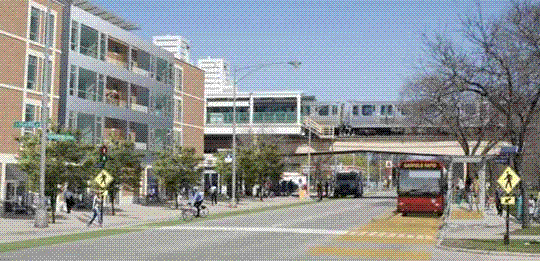 |  |  |  |  |
|





|
Massive BRT Plan To Boost Chicago Inner City Mobilitynov2011
When he assumed office early this summer, Chicago Mayor Rahm Emanuel announced that he would pursue the construction of a network of bus rapid transit lines in his city — in addition to the implementation of a number of bike lanes. A focus on buses in the Windy City is nothing new: The Chicago Transit Authority (CTA) carries almost a million riders a day on its network, it has moved forward quickly on three proposed corridors — one in the Loop downtown, another along Western Avenue, and a third along Jeffery Boulevard.
Another proposal by the influential Chicago-area Metropolitan Planning Council (MPC), , goes a lot further, promoting a $1.23 billion project that would dramatically improve connections between the city’s outlying neighbourhoods and reinforce the core network of commuter rail and the famous elevated ‘L’ lines. While Chicago, like all major cities, has a number of transportation priorities, an endorsement by Mr. Emanuel of this scheme as the city’s long-term plan could go a long way towards making the city a place where it is easier than ever to get around without a private car.
The proposal would add dedicated lanes, pre-paid fares, level boarding at defined stations every half-mile, and signal prioritisation to 152km of streets on ten corridors. The proposal would offer services every five to ten minutes during peak hours and every twelve to fifteen minutes at other times, perfectly adequate for most people, especially now that bus tracking is widely available. The effect on the city’s transportation connections would be significant: Far better linkages among existing ‘L’ and ‘Metra’ rail stations, improved access to currently transit-deprived areas, and the ability to bypass the Loop when making connections between neighbourhoods without losing time or experiencing poor service quality.
In order to select the corridors for investment, MPC analysed the city from a variety of perspectives: It considered which areas were least transit-accessible, which places had room for new development, and which streets were wide enough to provide for two dedicated bus lanes, in addition to car traffic, bike lanes, and generous sidewalks.
The selected itineraries would provide north-south and east-west routes that are completely ignored by today’s transit network, thereby allowing for easy interface with the rail system. They would take advantage of Chicago’s broad and straight streets and significantly speed up bus running times by reducing the amount of traffic vehicles encounter and limiting the number of times they stop. In total, the MPC estimates, these corridors would add 71,000 daily journeys to the region-wide total and reduce travel times for many more.
The city is advancing quite rapidly in transport terms, making more effective bus transit not just a vision but a soon-to-be reality. But the MPC proposal goes a step further than the city has been willing — or able — to do. The city is planning minimal investments in reserved lanes and some better stations, all of which will amount to slightly reduced travel times and a service quality that falls somewhere in between traditional bus operations and true BRT.
Unlike the Department of Transport, the MPC would encourage efficiency in the BRT network by encouraging adoption of system-wide standards along entire corridors: Visible, reserved lanes, level boarding, signal prioritisation, and off-board payment — all which would make Chicago’s system world class.
|


